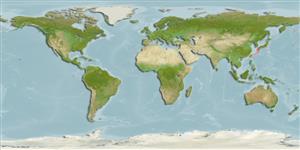>
Aulopiformes (Grinners) >
Paraulopidae (Cucumber fishes)
Etymology: Paraulopus: Paraulopus refers to a taxon related to Aulopus, both being included in the Aulopiformes..
Environment: milieu / climate zone / depth range / distribution range
Ökologie
seewasser bathydemersal; tiefenbereich 322 - 375 m (Ref. 49923). Deep-water
Northwest Pacific: Kyushu-Palau Ridge and the Emperor Seamounts.
Size / Gewicht / Alter
Maturity: Lm ? range ? - ? cm
Max length : 12.5 cm SL Männchen/unbestimmt; (Ref. 49923)
Kurzbeschreibung
Morphologie | Morphometrie
Rückenflossenstacheln (insgesamt): 0; Rückenflossenweichstrahlen (insgesamt): 11; Afterflossenstacheln 0; Afterflossenweichstrahlen: 8 - 10; Wirbelzahl: 42 - 44. Second and third dorsal fin rays very elongated, prolonged filamentously, extending when depressed well beyond adipose fin in males, not quite reaching adipose fin in females (Ref. 49923). Sexually dimorphic in dorsal and caudal fin coloration: dorsal fin with a black upper margin broader in males than in females; caudal fin white with a black posterior margin on each lobe in males, black margin absent in females (Ref. 49923).
Life cycle and mating behavior
Geschlechtsreife | Fortpflanzung | Ablaichen | Eier | Fecundity | Larven
Sato, T. and T. Nakabo, 2003. A revision of the Paraulopus oblongus group (Aulopiformes: Paraulopidae) with description of a new species. Ichthyol. Res. 50(2):164-177. (Ref. 49923)
IUCN Rote Liste Status (Ref. 130435)
Bedrohung für Menschen
Harmless
Nutzung durch Menschen
Mehr Information
NamenSynonymeMetabolismusRäuberÖkotoxikologieFortpflanzungGeschlechtsreifeAblaichenSpawning aggregationFecundityEierEientwicklung
Alter/GrößeWachstumLänge-GewichtLänge-LängeLängenhäufigkeitenMorphometrieMorphologieLarvenLarven Pop.Dyn.RekrutierungDichteBRUVS
ReferenzenAquakulturAquakultur ProfilZuchtlinienGenetikElectrophoresesVererbbarkeitKrankheitenVerarbeitungNutrientsMass conversion
PartnerBilderStamps, Coins Misc.LauteCiguateraGeschwindigkeitSchwimmstilKiemenoberflächeOtolithsGehirngrößeSehfähigkeit
Tools
Zusatzinformationen
Download XML
Internet Quellen
Estimates based on models
Phylogenetic diversity index (Ref.
82804): PD
50 = 0.5001 [Uniqueness, from 0.5 = low to 2.0 = high].
Bayesian length-weight: a=0.00389 (0.00180 - 0.00842), b=3.12 (2.94 - 3.30), in cm total length, based on all LWR estimates for this body shape (Ref.
93245).
Trophic level (Ref.
69278): 3.8 ±0.7 se; based on size and trophs of closest relatives
Fishing Vulnerability (Ref.
59153): Low vulnerability (10 of 100).
